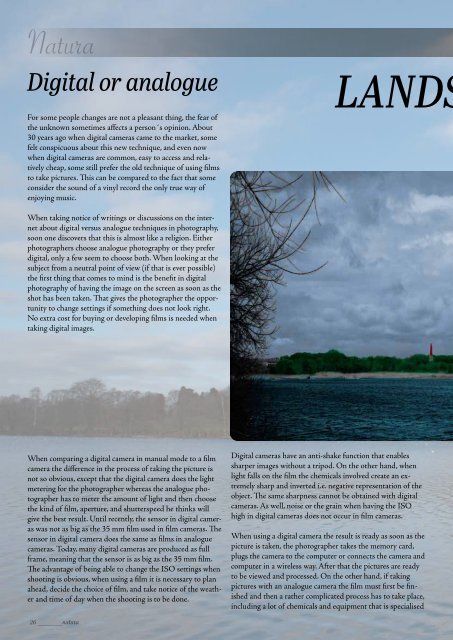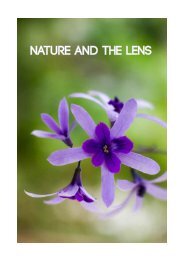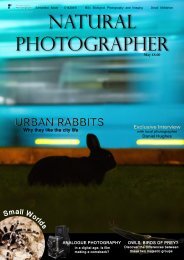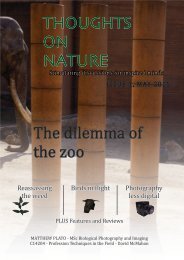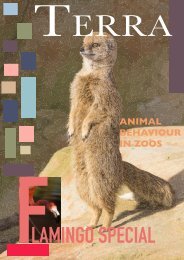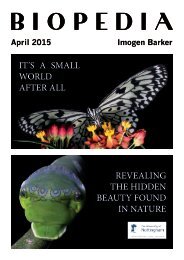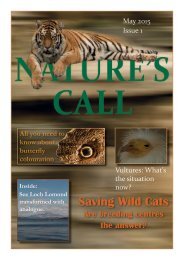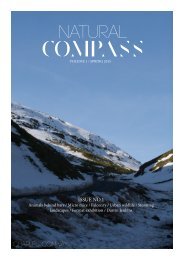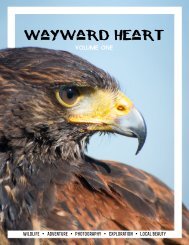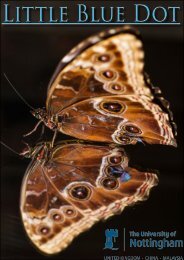NATURA
You also want an ePaper? Increase the reach of your titles
YUMPU automatically turns print PDFs into web optimized ePapers that Google loves.
Natura<br />
Digital or analogue<br />
For some people changes are not a pleasant thing, the fear of<br />
the unknown sometimes affects a person´s opinion. About<br />
30 years ago when digital cameras came to the market, some<br />
felt conspicuous about this new technique, and even now<br />
when digital cameras are common, easy to access and relatively<br />
cheap, some still prefer the old technique of using films<br />
to take pictures. This can be compared to the fact that some<br />
consider the sound of a vinyl record the only true way of<br />
enjoying music.<br />
When taking notice of writings or discussions on the internet<br />
about digital versus analogue techniques in photography,<br />
soon one discovers that this is almost like a religion. Either<br />
photographers choose analogue photography or they prefer<br />
digital, only a few seem to choose both. When looking at the<br />
subject from a neutral point of view (if that is ever possible)<br />
the first thing that comes to mind is the benefit in digital<br />
photography of having the image on the screen as soon as the<br />
shot has been taken. That gives the photographer the opportunity<br />
to change settings if something does not look right.<br />
No extra cost for buying or developing films is needed when<br />
taking digital images.<br />
LANDSCAPE<br />
Natura<br />
Landscape photography<br />
Similar things must be borne in mind when taking pictures<br />
of landscape whether it is with a digital or analogue camera.<br />
The first thing is to choose where to take the picture, what<br />
does the photographer want to say or show with the picture?<br />
The time of day is important, light conditions are often good<br />
or interesting in dusk or dawn with long shadows that make<br />
more depth in the picture. It is important to be in time at<br />
the place, to be able to choose the composition, look around,<br />
clean up the scene if necessary, think about leading lines, rule<br />
of third and if there is some disturbance in the picture. When<br />
using a digital camera this should be relatively easy, just take<br />
pictures, view them and decide where to position yourself. T<br />
The next thing is to decide the depth of field, and choose<br />
the settings on the camera. The whole scene should be the<br />
subject, so as much as possible should be in focus. If shooting<br />
with a telephoto lens, a decision must be made on how<br />
much to zoom and the effects of zooming on depth of field.<br />
When taking landscape pictures, the depth of the subject<br />
does matter, having distinct foreground, middleground and<br />
background to create a sense of dept. One thing that should<br />
be to considered is the possibility of having a movement in<br />
the picture, when shooting with slow shutter speed having<br />
water running, bird flying or some other movement can add<br />
something extra to the image.<br />
Image 27. Landscape with an analogue camera.<br />
When comparing a digital camera in manual mode to a film<br />
camera the difference in the process of taking the picture is<br />
not so obvious, except that the digital camera does the light<br />
metering for the photographer whereas the analogue photographer<br />
has to meter the amount of light and then choose<br />
the kind of film, aperture, and shutterspeed he thinks will<br />
give the best result. Until recently, the sensor in digital cameras<br />
was not as big as the 35 mm film used in film cameras. The<br />
sensor in digital camera does the same as films in analogue<br />
cameras. Today, many digital cameras are produced as full<br />
frame, meaning that the sensor is as big as the 35 mm film.<br />
The advantage of being able to change the ISO settings when<br />
shooting is obvious, when using a film it is necessary to plan<br />
ahead, decide the choice of film, and take notice of the weather<br />
and time of day when the shooting is to be done.<br />
26 _____natura<br />
Digital cameras have an anti-shake function that enables<br />
sharper images without a tripod. On the other hand, when<br />
light falls on the film the chemicals involved create an extremely<br />
sharp and inverted i.e. negative representation of the<br />
object. The same sharpness cannot be obtained with digital<br />
cameras. As well, noise or the grain when having the ISO<br />
high in digital cameras does not occur in film cameras.<br />
When using a digital camera the result is ready as soon as the<br />
picture is taken, the photographer takes the memory card,<br />
plugs the camera to the computer or connects the camera and<br />
computer in a wireless way. After that the pictures are ready<br />
to be viewed and processed. On the other hand, if taking<br />
pictures with an analogue camera the film must first be finished<br />
and then a rather complicated process has to take place,<br />
including a lot of chemicals and equipment that is specialised<br />
for this process. Many things can go wrong during this stage,<br />
but the advantage is that the person developing the film can<br />
have some creative effects on the final product.<br />
To make the process easier after developing a film, a scanner<br />
can be used to scan the film and by that make it digital. The<br />
quality of the scanner has to be good to retain the quality of<br />
the negative, but some say that there will always be some loss.<br />
As well, when handling the film, fingerprints and dust can<br />
affect the final product so great care must be taken regarding<br />
that. After the scanning, the process of developing the image<br />
can be the same as with pictures taken with digital cameras. In<br />
software like Photoshop it is possible to fix things, change colour<br />
or like is done on the image seen on this page; have a black<br />
and white image colourized.<br />
Image 28. Attenborough Nature Reserve. [Non-marked]<br />
natura_____27


